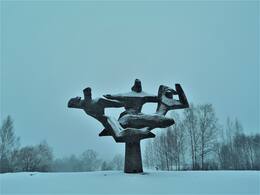About the crimes of Red Army soldiers in Tukums.
In Tukums, several monuments to the Red Army were erected during the Soviet occupation. Today, they still have not lost their former, Soviet ideological goals and continue to create the myth of the Red Army as liberators. A variety of sources have survived about the crimes of the Red Army soldiers. One group of sources can be found in local newspapers, which vividly describe the permissiveness and extent of the crimes of the Red Army.
(..) In Tukums, the Red Army soldiers murdered several residents [..] In those days and later, the Red Army soldiers raped women on a large scale. Acts of violence were committed even on 12-14 year old girls [..] The Red Army soldiers asked passers-by on the street for time, and when they were told, they took their watches. Wedding rings were removed from many people, bicycles were taken. It often happened that a Red Army soldier, entering a house, would shoot into the air and then completely rob the intimidated residents. (..).
(..) almost no dwelling of the Tukums residents was left unvisited by the Red Army soldiers. Watches, valuables, vodka, jam, honey - were the main values that were sought [..] A Red Army soldier detained a woman of about 30 years old and demanded: "Show me your teeth!" The woman opened her mouth, in which were several gold teeth. The Mongol, without thinking much, knocked the unfortunate woman's teeth out of her mouth right there on the street and left (..)"
The newspaper "Tukuma žinas". It is gone now. 1944, August 29.
Related timeline
Related topics
Related objects
Monument for the Freedom-Fighters
Located in Tukums, Mālkalns, Jelgavas Street 15A.
The monument was unveiled in 1975 to highlight the merits of the Red Army during World War II. It served as a means of Soviet ideology and propaganda, symbolically strengthening the presence of the occupation regime in Latvia and creating the myth of the Soviet regime as “liberators”. The author of the monument is sculptor and Tukums native Arta Dumpe.
After the capitulation of Germany on May 8, 1945, the Red Army perceived Kurzeme as a territory conquered by the enemy, not a liberated part of the USSR. The inhabitants of Kurzeme were enemies and their property was considered trophies of war. The repressive authorities and the army began the “cleansing of Kurzeme”. Men aged 16 to 60 were detained, registered and checked. In terms of danger, the inhabitants of Kurzeme – men – were equated with the military personnel of the capitulated Germany. The Red Army’s permissiveness and a wave of crimes began – murders, rapes, robberies, arrests and “disappearances of people”. The only armed resistance came from the National Partisan groups. The Soviet authorities created destroyer battalions, including in the Tukums district, to eliminate any opposition. The wave of violence and terror reached its peak in 1949, when deportations of the population took place throughout Latvia.
The monument can be seen today. Its symbolic meaning has been interpreted in various ways - a battle scene or a mother holding her sons fighting on opposite sides. The monument is set on a hill, from which a spectacular view opens.





